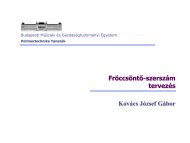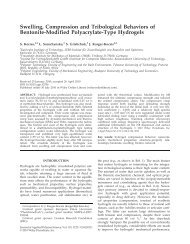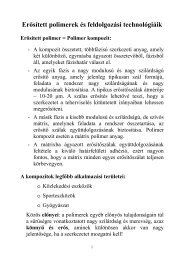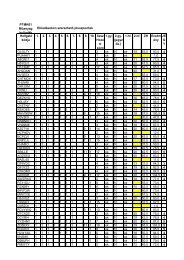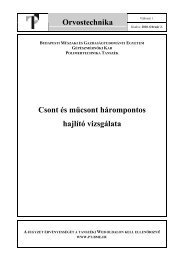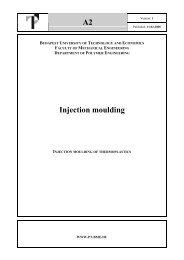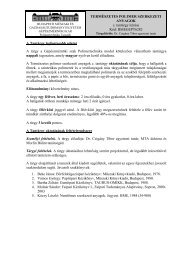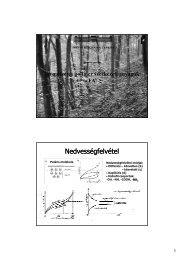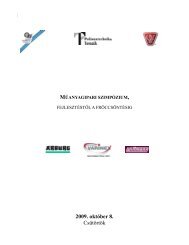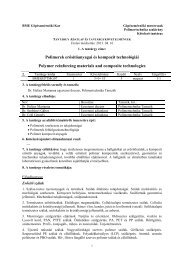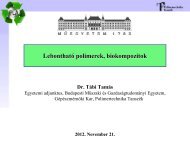Toughness Response of Vinylester/Epoxy-Based Thermosets of ...
Toughness Response of Vinylester/Epoxy-Based Thermosets of ...
Toughness Response of Vinylester/Epoxy-Based Thermosets of ...
Create successful ePaper yourself
Turn your PDF publications into a flip-book with our unique Google optimized e-Paper software.
2126 KARGER-KOCSIS, GRYSHCHUK, AND JOSTFigure 2 Possible chemical reactions during grafted IPNformation using VE and EP resins.The fracture surfaces were coated with an alloy <strong>of</strong>Au/Pd prior to SEM investigations.RESULTS AND DISCUSSIONSimultaneous IPN formationCuring <strong>of</strong> VE occurs via free radical copolymerizationwith styrene. On the other hand, crosslinking <strong>of</strong> EPwith diamine follows a polyaddition mechanism.These reactions are basically independent <strong>of</strong> one another,and as a consequence, a simultaneous IPNstructure may develop. There are, however, some sidereactions that make the scenario a bit more complicated.The primary amine group <strong>of</strong> the diamine hardenermay react with the double bonds <strong>of</strong> styrene andVE [reactions (a) and (b) in Fig. 2]. These side reactionsmay reduce the crosslink density <strong>of</strong> the VE component.Their effect is possibly negligible, as styrene ispresent in excess, and the free radical polymerization<strong>of</strong> VE is already activated by diethylaniline and thus isvery fast. The secondary OOH groups initiallypresent in VE and formed during the polyadditionreaction <strong>of</strong> the crosslinking EP may react with theepoxy groups <strong>of</strong> the EP resin [reaction (c) in Fig. 2]. Inthis way a chemical link between the EP and VEphases develops, and the related IPN is termedgrafted IPN. Figure 3 highlights the difference betweenthe IPN and grafted IPN structures. For agrafted IPN structure the related VE/EP versionsshould be quite sensitive to thermal treatment (postcuring).That was the reason for studying the mechanicalperformance <strong>of</strong> the thermoset compositions after apostcuring cycle.Considering the DMTA spectra, more exactly thetan-T traces, one can recognise a shift in the -relaxationtransition (T g ) toward higher temperatures dueto the annealing (postcuring) at T 200°C (Fig. 4).This shift is usual for all thermosets as new crosslinksform after the thermally-induced devitrification process.Therefore, the T g shift can not be attributed solelyto the formation <strong>of</strong> a more grafted IPN structure. Ahint for the grafted IPN structure should be likelyfound in the range between the - and -relaxations.Unfortunately, not even Fourier transformed infraredspectroscopy (FTIR) can help us to show the supposedgrafting, as the hydroxyl group “recovers” during therelated reaction [cf. reaction (c) in Fig. 2)]. Further, thetan -T traces in Figure 4 do not indicate unequivocallythe IPN formation. It would be expected that adoubling or at least a strong asymmetry in the -relaxationpeak would occur after low-temperature curing.A double -peak can only be recognized in VE/Cal-EPAl-Am cured up to T 150°C. Accordingly,the VE and the EP resins selected were very compatiblewith each other.Attention should also be paid to the -relaxationtransition. For the system with Cal-EPAl-Am, thispeak is substantially higher than in the EP composed<strong>of</strong> Al-EPCal-Am. Note that in the neat VE this peakis marginal. 23 Therefore, the onset <strong>of</strong> the -relaxationshould be related to the EP network. <strong>Based</strong> on analogies(discussed later) with linear amorphous copolyesterswith cyclohexylenedimethylene units along themacromolecular chain, the key parameter <strong>of</strong> the-transition can be identified: conformational transitions<strong>of</strong> the cyclohexylene rings. The -relaxation transitions<strong>of</strong> the VE/EP systems, shown in Figure 4,already suggest the possibility <strong>of</strong> some differenceswith the chair/boat transitions <strong>of</strong> the cyclohexylenegroups. It is believed that this conformational changeis somewhat restricted in Cal-Am, in which the movement<strong>of</strong> the two cyclohexylene rings are less decoupledfrom one another.Direct evidence for the onset <strong>of</strong> IPN was providedby AFM. Supposing that the resistance <strong>of</strong> VE to Ar ion bombardment differs from that <strong>of</strong> EP, the “ionetching” technique is a reliable way <strong>of</strong> detecting theinitial morphology. Figure 5 shows AFM pictures onthe ion-etched surface <strong>of</strong> VE/Cal-EPAl-Am cured atT 150°C. The morphology is obviously a cocontinuoustwo-phase structure. Attention should be paid tothe disperse-type microstructure <strong>of</strong> VE (microgelled
TOUGHNESS OF VE/EP OF IPN STRUCTURE 2127Figure 3Difference between simultaneously formed IPN (a) with and (b) without grafting schematically.crosslinked VE particles are embedded in a polystyrenematrix), 24 which is completely different from thatwhich we found (cf. Fig. 5). To clarify the morphologicalpeculiarities <strong>of</strong> the VE/EPs studied, further tests(AFM, SEM) are now in progress.Effects <strong>of</strong> EP formulation on (fracture) mechanicalpropertiesTable I lists the basic mechanical properties <strong>of</strong> theVE/EP compositions. The related data clearly suggestthe strong effect <strong>of</strong> the hardener type. The use <strong>of</strong>Al-Am resulted in a thermoset with a low T g , lowstiffness, and low strength and very high ductility.The highest stiffness, strength, and T g associated withthe lowest ductility was shown by the VE/Cal-EPCal-Am. As expected, all systems were sensitiveto postcuring, the effect <strong>of</strong> which is different, however,for the various EP formulations. The most sensitiveindicator for this thermal treatment was the T g .The ranking <strong>of</strong> the VE/EP systems differed when,instead <strong>of</strong> the tensile mechanical properties, the fracturemechanical properties were taken into account.Figure 4 tan versus T traces for VE/EP combinationsafter curing at max. T 150°C and 200°C, respectively.Figure 5 AFM picture (height image) showing the formation<strong>of</strong> an IPN structure with the example <strong>of</strong> VE/Cal-EPAl-Am after curing at T 200°C.
2128 KARGER-KOCSIS, GRYSHCHUK, AND JOSTTABLE ITensile Mechanical Properties <strong>of</strong> VE/EP (1/1) Systems StudiedCompositionMaximum curingtemperature(°C)Tensilestrength(MPa)Ultimatetensile strain(%)Young’smodulus[MPa]T g(°C)VE/AlEPAlAm 150 — a — a — a 15VE/A1EPCalAm 150 50 5.5 1311 81VE/AlEPCalAm 200 60 4.5 1347 128VE/CalEPCalAm 150 54 4.5 1347 96VE/CalEPCalAm 200 62 4.3 1447 138VE/CalEPAlAm 150 14 38.5 345 57VE/CalEPAlAm 200 46 5.1 1434 87a Not tested.Notes: data represent mean values derived from five parallel tests. T g read from the DMTA curve as the maximum <strong>of</strong> the-relaxation peak.Figure 6 shows the benefits <strong>of</strong> EP networking on thefracture mechanical parameters when Al-EPCal-Amand Cal-EPAl-Am combinations are used. The fullycycloaliphatic version, that is, Cal-EPCal-Am, had ahigh K c ; however, it was very brittle (low G c ). On theother hand, this system was less sensitive to postcuring(cf. results in Table I and Fig. 6). It would beexpected that postcuring at T 200°C would reduceG c and increase K c at the same time. This expectationholds for VE/Cal-EPAl-Am but not for VE/Al-EPCal-Am, for which the reverse tendency was observed.On the supposition that VE crosslinking is notaffected by the EP system, changes in the mechanicaland fracture mechanical properties should be relatedto the EP network characteristics. Figure 7 depicts theideal network units <strong>of</strong> the EP systems used. The resultsin Table I and Figure 6 suggest that the keyaspect is the presence <strong>of</strong> the cyclohexylene units. Intheir absence (cf. VE/Al-EPAl-Am) a low T g systemwith moderate (thermo)mechanical properties was theoutcome. In addition, the EP network unit in Cal-EPCal-Am was rather stiff. Further, the chair/boatconformational changes along the hardener segmentswere hampered, as they require some cooperative mo-Figure 6 (a) Fracture energy, G c , and (b) fracture toughness,K c , <strong>of</strong> VE/EP combinations as a function <strong>of</strong> EP formulationand maximum curing temperature. Note: no validfracture mechanical data could be determined for the VE/Al-EPAl-Am combinations because <strong>of</strong> their high ductilityat room temperature.Figure 7 Idealized EP network units as a function <strong>of</strong> theirconstituents. Note: the unit rigidity increases in clockwisedirection; flexibility increase as a result <strong>of</strong> the ether linkagesis indicated.
TOUGHNESS OF VE/EP OF IPN STRUCTURE 2129Figure 8 -relaxation transition VE/Cal-EPAl-Am andVE/Al-EPCal-Am combinations after curing at max. T 150°C and T 200°C, respectively.tion. This is why this system exhibited outstandingstrength, high K c , high T g , and, at the same time, lowductility and very low G c . The combination Cal-EPAl-Am yielded a network unit <strong>of</strong> high flexibility.This is because <strong>of</strong> the ether linkages and the lessrestricted conformational changes <strong>of</strong> the cyclohexylenegroups along the EP segment. When the EP networkunit consisted <strong>of</strong> Al-EPCal-Am, its overall flexibility(i.e., all distortion possibilities) was somewhatreduced as a result <strong>of</strong> the presence <strong>of</strong> the two cyclohexylenegroups in the hardener, compared with theCal-EPAl-Am formulation. This rationale is in linewith the DMTA results. Figure 8 shows that the -relaxation<strong>of</strong> VE/Al-EPCal-Am was considerably lessintense than that <strong>of</strong> VE/Cal-EPAl-Am. It is worth <strong>of</strong>noting that the flexibility <strong>of</strong> the network unit alsohelped us to explain the changes observed after postcuring:the more flexible the network unit, the higheris the effect <strong>of</strong> the thermal treatment. In addition, thenetwork unit flexibility should influence the graftingreaction that occurs between the OOH(VE) and epoxy(EP)groups.Figure 9 SEM picture taken on the fracture surface <strong>of</strong>VE/Cal-EPCal-Am after curing at T 150°C. 150°C [Fig. 11(a)] and T 200°C [Fig. 11(b)]. Thefracture surface <strong>of</strong> the low-temperature-cured systemis fully analogous with that <strong>of</strong> a linear copolyesterFailure modeThe fracture surface <strong>of</strong> VE/Cal-EPCal-Am wasrather smooth (cf. Fig. 9). This suggests a very low G c ,as was indeed found. The surface pattern <strong>of</strong> the riverlines 25 at a high crack speed was a result <strong>of</strong> the formation<strong>of</strong> satellite cracks on slightly different planesthan the dominating one. As the basic failure mode <strong>of</strong>the thermosets was shear, the height <strong>of</strong> these river linesteps provided the first hint about the ductility andthus the G c <strong>of</strong> the material. Figure 10(a) shows evidence<strong>of</strong> more ductility on the still-brittle fracturesurface <strong>of</strong> VE/Al-EPCal-Am. Both the height andwidth <strong>of</strong> the river lines were strongly reduced afterpostcuring at T 200°C [Fig. 10(b)]. As a consequence,G c was also reduced which is in line with the experimentalfindings [cf. Fig. 6(a)]. Figure 11 shows thefailure mode <strong>of</strong> VE/Cal-EPAl-Am after curing at TFigure 10 SEM pictures taken on the fracture surface <strong>of</strong>VE/Al-EPCal-Am after curing at (a) T 150°C and (b) T 200°C.
2130 KARGER-KOCSIS, GRYSHCHUK, AND JOSTcontaining cyclohexylenedimethylene units [compareFig. 11(a) with Fig. 12]. 26 The superior toughness <strong>of</strong>this amorphous thermoplastic copolyester can be attributedto the conformational transition <strong>of</strong> the cyclohexylenegroup being able to couple with the motion<strong>of</strong> neighboring segments. 27–28 The strong similaritybetween VE/Cal-EPAl-Am [Fig. 11(a)] and the thermoplasticcopolyester (Fig. 12) can be interpreted byconsidering the only common component, that is, thecyclohexylene group. It should also be noted here thatthis amorphous copolyester always fails by shear deformation.29 The most peculiar feature <strong>of</strong> VE/Cal-EPAl-Am is that its initial failure mode did notchange with postcuring. The arrow in Figure 11(b)shows that the high fracture toughness was a result <strong>of</strong>ductile deformation; however, this occurred in a muchshorter range than in the specimen cured at T 150°C[cf. Fig. 11(a,b)]. The fracture surface after the ductile/brittle transition still indicates enhanced shear deformability<strong>of</strong> this composition [compare the riverlines in Fig. 11(b) with the SEM pictures in Fig. 10].Figure 12 SEM picture <strong>of</strong> the fracture surface <strong>of</strong> an amorphouscopolyester. Note: molecular characteristics <strong>of</strong> thismaterial are disclosed in ref. 26; fracture occurred at ambienttemperature with 1 mm/min crosshead speed; notch is visiblein the bottom left corner.Given that the intensity <strong>of</strong> the -relaxation did notchange because <strong>of</strong> postcuring (cf. Fig. 8), it can beclaimed that the toughness <strong>of</strong> the system correlateswith the intensity <strong>of</strong> this relaxation transition. Additionalsupport for this argument is provided by previouslymentioned analogy with amorphous copolyesters.26,29 The fractographic work corroborated thatthe supposedly grafted IPN structure, along with thenetwork unit flexibilization <strong>of</strong> the EP constituent, areexcellent tools to enhance the toughness <strong>of</strong> thermosets.CONCLUSIONS<strong>Based</strong> on the results <strong>of</strong> this work, which investigatedthe effect <strong>of</strong> EP formulation on the toughness response<strong>of</strong> a VE/EP thermoset combination at a ratio <strong>of</strong> 1:1, thefollowing conclusions can be drawn:Figure 11 SEM pictures taken on the fracture surface <strong>of</strong>VE/Cal-EPAl-Am after curing at (a) T 150°C and (b) T 200°C. Note: arrow in picture (b) shows the initial ductiledeformation.• The structure <strong>of</strong> the VE/EP is <strong>of</strong> the IPN type, asshown by the results <strong>of</strong> atomic force microscopy(see also ref. 30). However, no direct evidence wasfound for its grafted nature.• Flexibilization by using an EP resin or diaminehardener containing cyclohexylene units stronglyenhances the stiffness and strength comparedwith fully aliphatic EP versions. Though the Cal-EPCal-Am combination possesses high strength,but its toughness is very low when compared with“hybrid” EPs containing cycloaliphatic units in eitherthe resin (Cal-EPAl-Am) or the hardener (Al-EPCal-Am).• The intensity <strong>of</strong> the -relaxation correlates withthe toughness. This transition was assigned toconformational changes <strong>of</strong> the cyclohexylene linkages(chair/boat transition). This finding suggeststhat molecular dynamics simulation may be a
TOUGHNESS OF VE/EP OF IPN STRUCTURE 2131valuable tool for developing thermosets that haveenhanced toughness and improved mechanicaland thermal properties.The authors thank DSM Composite Resins and U. PrümmerPolymer–Chemie GmbH (UPPC) for providing us with materialsamples.References1. Park, S.-J.; Jin, J.-S. J Appl Polym Sci 2001, 82, 775.2. Chern, Y. C.; Tseng, S. M.; Hsieh, K. H. J Appl Polym Sci 1999,74, 328.3. Hsieh, K. H.; Han, J. L.; Yu, C. T.; Fu, S. C. Polymer 2001, 42,2491.4. Cascaval, C. N.; Ciobanu, C.; Rosu, D.; Rosu, L. J. Appl PolymSci 2002, 83, 138.5. Meyer, G. C.; Mehrenberger, P. Y. Eur Polym J 1977, 13, 383.6. Hsu, T. J.; Lee, J. L. Polym Compos 1985, 25, 951.7. Hua, F.-J.; Hu, C.-P. J Polym Sci, Part A: Poly Chem 1999, 37, 3568.8. Vabrik, R.; Czajlik, I.; Túry, G.; Rusznák, I.; Ille, A.; Víg, A.J Appl Polym Sci 1998, 68, 111.9. Chakrabarty, D.; Das, B.; Roy, S. J Appl Polym Sci 1998, 67, 1051.10. Sands, J. M.; Jensen, R. E.; Fink, B. K.; McKnight, S. H. J ApplPolym Sci 2001, 81, 530.11. Chou, Y. C.; Lee, J. L. Polym Eng Sci 1994, 34, 1239.12. Wang, G. Y.; Zhu, M. Q.; Hu, C. P. J. Polym Sci: Part A: Chem2000, 38, 136.13. Chen, C.-H.; Chen, W.-J.; Chen, M.-H.; Li, Y.-M. J Appl PolymSci 1999, 71, 1977.14. Chen, C.-H.; Chen, W.-J.; Chen, M.-H.; Li, Y.-M. Polymer 2000,41, 7961.15. Dean, K.; Cook, W. D.; Rey, L.; Galy, J.; Sautereau, H. Macromolecules2001, 34, 6623.16. Dean, K.; Cook, W. D.; Burchill, P.; Zipper, M. Polymer 2001, 42,3589.17. Dean, K.; Cook, W. D.; Zipper, M. D.; Burchill, P. Polymer 2001,42, 1345.18. Ivankovic, M.; Dzodan, N.; Brnardic, I.; Mencer, H. J. J ApplPolym Sci 2002, 83, 2689.19. Lin, M.-S.; Liu, C.-C.; Lee, C.-T. J Appl Polym Sci 1999, 72, 585.20. Karger-Kocsis, J.; Gryshchuk, O.; Jost, N. SPE-ANTEC 2002, 60,751.21. Institut für Verbundwerkst<strong>of</strong>fe GmbH. Ger. Pat. applied for(2001).22. Williams, J. G. In Fracture Mechanics Testing Methods for PolymersAdhesives and Composites, ESIS Publ 28; Moore, D. R.,Pavan, A., Williams, J. G., Eds.; Elsevier Science: Oxford, UK,2001; p 11.23. Gryshchuk, O.; Jost, N.; Karger-Kocsis, J. J Appl Polym Sci 2002,84, 672.24. Mortaigne, B.; Feltz, B.; Laurens, P. J Appl Polym Sci 1997, 66,1703.25. Hull, D. Fractography, Cambridge University Press: Cambridge,UK, 199; pp 277–278.26. Karger-Kocsis, J.; Czigány, T.; Moskala, E. J. Polymer 1997, 38,4587.27. Liu, J.; Yee, A. F. Macromolecules 1998, 31, 7865.28. Chen, L. P.; Yee, A. F.; Moskala, E. J. Macromolecules 1999, 32,5944.29. Karger-Kocsis, J. In Handbook <strong>of</strong> Thermoplastic Polyesters; Fakirov,S., Ed.; Wiley-VCH: Weinheim, Germany, 2002; Chapter16, pp 717–753.30. Karger-Kocsis, J.; Gryshchuk, O.; Schmitt, S. J Mater Sci 2003, 38,413.



